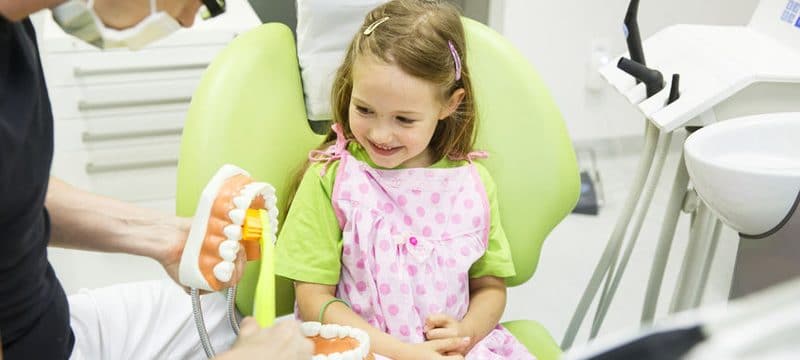
Taking care of dental health needs to be started right from when the first teeth erupt. But it is not enough to focus on dental health when the first teeth come up – oral health and hygiene of children needs to be given importance even before that. Making sure that the mouth of infants are cleaned after they drink milk or juice, taking care to make sure that they are weaned away from thumb sucking or from using pacifiers is all part of paediatric dentistry.
Dental health of children cannot be treated the same way as those of adults. Many of them are worried when they have to go to dentists – so it is important that the specialists are trained and skilled to make the children comfortable in their clinic and treat them efficiently. Paediatric dentistry helps in the early detection and treatment of dental problems of children. It also involves guiding parents in ensuring that the dental health of their children is maintained.
Children also have dental problems similar to adults. Dental health of children needs to be taken care of right from infancy to the time they reach adulthood. Some of the common dental procedures are discussed below.
Teeth Removal or Extraction
Removing teeth in children is a fairly common procedure that one can come across in paediatric dentistry. Dental procedures take two different forms – simple and surgical procedures. They are meant for different requirements. As the name suggests – a simple dental procedure is for pulling out teeth in children. Dentists perform this procedure in their clinic using forceps. This is usually done when baby teeth are ready to fall out – but for various reasons they do not come out readily when tried at home – this is when the help of dentists is desirable. To avoid pain, local anaesthesia is given to children, the numbness will go away after some time.
Surgical dental procedure is conducted when the teeth is locked in the jaw bone. Teeth can be fully embedded or partially embedded. Anaesthesia is needed in this procedure as this requires cutting away of the jaw bone and extracting the teeth. In some cases, dentists will recommend teeth removal as part of the treatment plan that is decided for your children.
It is important that precautions are followed after teeth removal. Dentists will usually inform parents on the care they need to follow after teeth removal. Being careful or even avoiding eating or drinking after teeth removal is advised. Drinking using a straw is also not advised as if it is done after the procedure then it might move the blood clot that is formed in the place where teeth are extracted – this will lead to bleeding in that area. Doubts should be cleared with the dentists when you go for the procedures.
Dental cleaning
Cleaning helps to promote good oral health and hygiene and also clean plaque and tartar from teeth. Food that children consume has more sugar content in them. If it is not properly cleaned, then it gets stuck to the teeth. Bacteria act upon them and gives out an acid that erodes the teeth. It eats up the teeth and leads to teeth decay. Gums and oral tissues can also get affected due to this.
For this procedure, the dentist will use special tools to assess the nature of plaque build-up. Tartar will be scrapped off and then teeth is brushed and flossed to clean it thoroughly. This examination of the teeth will also help in detecting any other dental problems. Subsequent corrective treatment also can be planned if needed. To prevent further damage, some dentists will suggest dental sealants for children to further check tooth damage. This is usually applied to milk teeth and helps to serve as a barrier to bacterial attack.
Dental Fillings
Even though milk teeth give way to permanent teeth, proper care and attention need to be given to baby teeth. Helping children understand the importance of oral hygiene is important as it helps them to follow good oral hygiene throughout their adult life. Tooth decay can happen in children and to maintain oral health it becomes important that dental fillings are used.
Dental fillings usually come in two different forms for children – white composite and metal. Metal fillings are favoured for children as they are cost effective and takes comparatively less time to be applied. For applying the filling, the cavity needs to be cleaned and decay will be removed – drilling and cleaning of the cavity is done and then the cavity is filled.
Going for dental consultations should be considered for children also – this helps to know the current state of the oral health of the child. What are the precautions that need to be taken to ensure good oral health of the child can be taken care by way of dental consultations and guidance.
After dental procedures are done, it is important that post procedural care is given due importance. As it is not enough that just procedures are completed but also the follow up care needs to be taken care of. Otherwise these procedures do not get the desired effect one is looking for.
Milk teeth will fall away, so they do not need much care – this is a wrong notion to have. The positioning of the milk teeth, the health of the teeth and also that of the gums all affect the nature and health of adult teeth. If gum infection takes away the health of the gums, then they will not have the strength to support future adult teeth. Moreover dental health often reflects the overall health of a person. So, it is important that oral health and hygiene of children are taken care of right from the start and make sure that the children understand the importance of following good oral hygiene practices.
